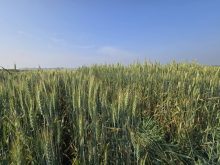The apparent transition into a wetter period means different diseases to watch out for, says David Kaminski, field crop pathologist with Manitoba Agriculture.
Kaminski was speaking at the CropConnect conference in Winnipeg on February 15.
Two crops dominate Manitoba’s agricultural landscape. Wheat and canola account for 70 per cent of the annual crop acres in the province. “We have a strong reliance on those two crops,” said Kaminski. “And that means in many cases, we’re growing those crops more frequently than perhaps we should.”
Read Also

Manitoba boosts stake in cereals centre to $23.5 million
Premier Wab Kinew said the additional project funds will help ‘Trump-proof’ the provincial economy.
For that reason, the diseases that affect those crops tend to be the ones that are of greatest concern to Manitoba farmers.
Diseases to watch for in canola
Kaminski predicts that verticillium stripe in canola will become more prevalent and severe in 2023. “Verticillium stripe is the new kid on the block,” said Kaminski. “It’s now on our radar because it has had a steady increase in prevalence over the last five years. It’s still not anywhere near the prevalence of blackleg, but it’s rising, and that’s a concern,” he says.
“Most of the time we see the disease when we’re cutting the stems at the time of our general survey,” says Kaminski. “We cut them right near the base of the plant.” The stems usually show bleaching. “Microsclerotia are under the skin, they’re in the water conducting vessels and they’re even in the pits,” said Kaminski. “There are millions and millions of them. And they probably interfere with the uptake of moisture and nutrients.”

Kaminski says clubroot will also likely be a concern this coming year. “It will likely be found in new geographies, that is, in RMs where it has not yet been detected,” he said. Clubroot is mainly seen in black soil regions, which are of course abundant in this province. Clubroot causes swellings, known as galls, to form on the root that can ultimately kill the plant.
According to the Canola Council of Canada, there are currently no cost-effective control measures available to remove this pathogen from an infested field. But there are clubroot resistant cultivars available.
Diseases in cereal crops
“2022 was the first year in quite a while that you can describe as wetter, or maybe it was a return to more normal conditions for Manitoba,” said Kaminski. After a spate of dry years, many expected a sudden increase in the incidence and severity of diseases in field crops. “This was true in some cases, but not in others; there were some surprises in 2022.”
Fusarium head blight was one of those surprises. The predictive maps released in 2022 showed a lot of red areas where there was a lot of concern, but in the end, fusarium head blight didn’t cause much of a problem. “We did see a rebound in the prevalence of fusarium head blight, that is, in 50% of the crops that we surveyed and had some,” explained Kaminksi. “But the incidence was fairly low—less than 5 per cent of the plants showed symptoms, and the disease severity was also very low,” he said. “You probably didn’t see it in your harvest.”
Fusarium head blight propagates with both high temperatures and high humidity. There was lots of humidity and lots of heat in 2022, but they didn’t often coincide. Nevertheless, Kaminski says it’s something farmers should be on the lookout for in 2023.
Crown rust in oats is another pathogen that could be a concern. Clubroot can cause yield losses as well as affect grain quality. It develops best during warm, sunny days and mild nights with good dew formation. It can be spread over long distances by the wind.
“It’ll depend on management,” says Kaminski. “Especially the varieties you grow.” He points out that many varieties that are available have good resistance, but ones that have been around longer often see a decline. The Seed Manitoba guide has good resources for selecting the best varieties.
















